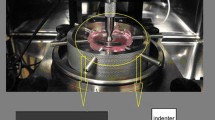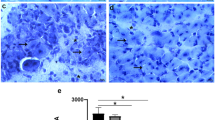Abstract
The molecular mechanisms that contribute to the pathogenesis of pressure-induced deep tissue injury are largely unknown. This study tested the hypothesis that oxidative stress and DNA damage signalling mechanism in skeletal muscle are involved in deep tissue injury. Adult Sprague Dawley rats were subject to an experimental protocol to induce deep tissue injury. Two compression cycles with a static pressure of 100 mmHg was applied to an area of 1.5 cm2 over the mid-tibialis region of right limb of the rats. The left uncompressed limb served as intra-animal control. Muscle tissues underneath compression region were collected for examination. Our analyses indicated that pathohistological characteristics including rounding contour of myofibres and extensive nuclei accumulation were apparently shown in compressed muscles. The elevation of 8OHdG immunopositively stained nuclei indicated the presence of oxidative DNA damage. Increase in oxidative stress was revealed by showing significant elevation of 4HNE and decreases in mRNA abundance of SOD1, catalase and GPx, and protein content of SOD2 in compressed muscles relative to control muscles. Increase in nitrosative stress was demonstrated by significant elevation of nitrotyrosine and NOS2 mRNA content. The activation of tumor suppressor p53 signalling was indicated by the remarkable increases in protein contents of total p53 and serine-15 phosphorylated p53. The transcript expression of the DNA-repairing enzyme, Rad23A, was significantly suppressed in compressed muscles. Our time-course study indicated that increased oxidative/nitrosative stress and proapoptotic signalling were maintained in muscles receiving increasing amount of compression cycles and post-compression time. Furthermore, resveratrol was found to attenuate the histological damage, oxidative/nitrosative stress and proapoptotic signalling in response to prolonged moderate compression. In conclusion, our findings are consistent with the hypothesis that oxidative stress and DNA damage signalling in skeletal muscle are involved in the underlying mechanisms responsible for the pathogenesis of pressure-induced deep tissue injury.















Similar content being viewed by others
References
Ankrom MA, Bennett RG, Sprigle S, Langemo D, Black JM, Berlowitz DR, Lyder CH (2005) Pressure-related deep tissue injury under intact skin and the current pressure ulcer staging systems. Adv Skin Wound Care 18:35–42
Barbenel JC (1991) Pressure management. Prosthet Orthot Int 15:225–231
Bennett G, Dealey C, Posnett J (2004) The cost of pressure ulcers in the UK. Age Ageing 33:230–235
Black J, Baharestani MM, Cuddigan J, Dorner B, Edsberg L, Langemo D, Posthauer ME, Ratliff C, Taler G (2007) National pressure ulcer advisory panel’s updated pressure ulcer staging system. Adv Skin Wound Care 20:269–274
Bouten CV, Oomens CW, Baaijens FP, Bader DL (2003) The etiology of pressure ulcers: skin deep or muscle bound? Arch Phys Med Rehabil 84:616–619
Canman CE, Lim DS, Cimprich KA, Taya Y, Tamai K, Sakaguchi K, Appella E, Kastan MB, Siliciano JD (1998) Activation of the ATM kinase by ionizing radiation and phosphorylation of p53. Science 281:1677–1679
Chen WY, Rogers AA (2007) Recent insights into the causes of chronic leg ulceration in venous diseases and implications on other types of chronic wounds. Wound Repair Regen 15:434–449
Choi HJ, Seon MR, Lim SS, Kim JS, Chun HS, Park JH (2008) Hexane/ethanol extract of Glycyrrhiza uralensis licorice suppresses doxorubicin-induced apoptosis in H9c2 rat cardiac myoblasts. Exp Biol Med (Maywood) 233:1554–1560
Chua CC, Liu X, Gao J, Hamdy RC, Chua BH (2006) Multiple actions of pifithrin-alpha on doxorubicin-induced apoptosis in rat myoblastic H9c2 cells. Am J Physiol Heart Circ Physiol 290:H2606–H2613
Cordeiro MB, Antonelli EJ, da Cunha DF, Junior AA, Junior VR, Vannucchi H (2005) Oxidative stress and acute-phase response in patients with pressure sores. Nutrition 21:901–907
Daniel RK, Priest DL, Wheatley DC (1981) Etiologic factors in pressure sores: an experimental model. Arch Phys Med Rehabil 62:492–498
Desneves KJ, Todorovic BE, Cassar A, Crowe TC (2005) Treatment with supplementary arginine, vitamin C and zinc in patients with pressure ulcers: a randomised controlled trial. Clin Nutr 24:979–987
Diegelmann RF (2003) Excessive neutrophils characterize chronic pressure ulcers. Wound Repair Regen 11:490–495
Dirks Naylor AJ (2009) Cellular effects of resveratrol in skeletal muscle. Life Sci 84:637–640
Donnelly J (2005) Should we include deep tissue injury in pressure ulcer staging systems? The NPUAP debate. J Wound Care 14:207–210
Garcia AD, Thomas DR (2006) Assessment and management of chronic pressure ulcers in the elderly. Med Clin North Am 90:925–944
Hatoko M, Tanaka A, Kuwahara M, Yurugi S, Iioka H, Niitsuma K (2002) Difference of molecular response to ischemia-reperfusion of rat skeletal muscle as a function of ischemic time: study of the expression of p53, p21(WAF-1), Bax protein, and apoptosis. Ann Plast Surg 48:68–74
Houwing R, Overgoor M, Kon M, Jansen G, van Asbeck BS, Haalboom JR (2000) Pressure-induced skin lesions in pigs: reperfusion injury and the effects of vitamin E. J Wound Care 9:36–40
Jackson JR, Ryan MJ, Hao Y, Alway SE (2010) Mediation of endogenous antioxidant enzymes and apoptotic signaling by resveratrol following muscle disuse in the gastrocnemius muscles of young and old rats. Am J Physiol Regul Integr Comp Physiol 299:R1572–R1581
James TJ, Hughes MA, Cherry GW, Taylor RP (2003) Evidence of oxidative stress in chronic venous ulcers. Wound Repair Regen 11:172–176
Juhasz B, Mukherjee S, Das DK (2010) Hormetic response of resveratrol against cardioprotection. Exp Clin Cardiol 15:e134–e138
Kwan MP, Tam EW, Lo SC, Leung MC, Lau RY (2007) The time effect of pressure on tissue viability: investigation using an experimental rat model. Exp Biol Med (Maywood) 232:481–487
Leonard SS, Xia C, Jiang BH, Stinefelt B, Klandorf H, Harris GK, Shi X (2003) Resveratrol scavenges reactive oxygen species and effects radical-induced cellular responses. Biochem Biophys Res Commun 309:1017–1026
Linder-Ganz E, Engelberg S, Scheinowitz M, Gefen A (2006) Pressure–time cell death threshold for albino rat skeletal muscles as related to pressure sore biomechanics. J Biomech 39:2725–2732
Linder-Ganz E, Gefen A (2004) Mechanical compression-induced pressure sores in rat hindlimb: muscle stiffness, histology, and computational models. J Appl Physiol 96:2034–2049
Mokni M, Limam F, Elkahoui S, Amri M, Aouani E (2007) Strong cardioprotective effect of resveratrol, a red wine polyphenol, on isolated rat hearts after ischemia/reperfusion injury. Arch Biochem Biophys 457:1–6
Momken I, Stevens L, Bergouignan A, Desplanches D, Rudwill F, Chery I, Zahariev A, Zahn S, Stein TP, Sebedio JL, Pujos-Guillot E, Falempin M, Simon C, Coxam V, Andrianjafiniony T, Gauquelin-Koch G, Picquet F, Blanc S (2011) Resveratrol prevents the wasting disorders of mechanical unloading by acting as a physical exercise mimetic in the rat. FASEB J 25:3646–3660
Nola GT, Vistnes LM (1980) Differential response of skin and muscle in the experimental production of pressure sores. Plast Reconstr Surg 66:728–733
Palozza P, Serini S, Di NF, Boninsegna A, Torsello A, Maggiano N, Ranelletti FO, Wolf FI, Calviello G, Cittadini A (2004) beta-Carotene exacerbates DNA oxidative damage and modifies p53-related pathways of cell proliferation and apoptosis in cultured cells exposed to tobacco smoke condensate. Carcinogenesis 25:1315–1325
Perra MT, Maxia C, Corbu A, Minerba L, Demurtas P, Colombari R, Murtas D, Bravo S, Piras F, Sirigu P (2006) Oxidative stress in pterygium: relationship between p53 and 8-hydroxydeoxyguanosine. Mol Vis 12:1136–1142
Pluquet O, Hainaut P (2001) Genotoxic and non-genotoxic pathways of p53 induction. Cancer Lett 174:1–15
Saleem A, Adhihetty PJ, Hood DA (2009) Role of p53 in mitochondrial biogenesis and apoptosis in skeletal muscle. Physiol Genomics 37:58–66
Salzberg CA, Byrne DW, Cayten CG, van Niewerburgh P, Murphy JG, Viehbeck M (1996) A new pressure ulcer risk assessment scale for individuals with spinal cord injury. Am J Phys Med Rehabil 75:96–104
Sener G, Sert G, Ozer SA, Arbak S, Gedik N, Ayanoglu-Dulger G (2006) Melatonin protects against pressure ulcer-induced oxidative injury of the skin and remote organs in rats. J Pineal Res 40:280–287
Shieh SY, Ikeda M, Taya Y, Prives C (1997) DNA damage-induced phosphorylation of p53 alleviates inhibition by MDM2. Cell 91:325–334
Siu PM, Alway SE (2005) Id2 and p53 participate in apoptosis during unloading-induced muscle atrophy. Am J Physiol Cell Physiol 288:C1058–C1073
Siu PM, Alway SE (2005) Mitochondria-associated apoptotic signalling in denervated rat skeletal muscle. J Physiol 565:309–323
Siu PM, Tam EW, Teng BT, Pei XM, Ng JW, Benzie IF, Mak AF (2009) Muscle apoptosis is induced in pressure-induced deep tissue injury. J Appl Physiol 107:1266–1275
Siu PM, Teng BT, Pei XM, Tam EW (2011) Proteasome inhibition alleviates prolonged moderate compression-induced muscle pathology. BMC Musculoskelet Disord 12:58
Stekelenburg A, Oomens CW, Strijkers GJ, Nicolay K, Bader DL (2006) Compression-induced deep tissue injury examined with magnetic resonance imaging and histology. J Appl Physiol 100:1946–1954
Sundin BM, Hussein MA, Glasofer S, El-Falaky MH, Abdel-Aleem SM, Sachse RE, Klitzman B (2000) The role of allopurinol and deferoxamine in preventing pressure ulcers in pigs. Plast Reconstr Surg 105:1408–1421
Tamilselvan J, Jayaraman G, Sivarajan K, Panneerselvam C (2007) Age-dependent upregulation of p53 and cytochrome c release and susceptibility to apoptosis in skeletal muscle fiber of aged rats: role of carnitine and lipoic acid. Free Radic Biol Med 43:1656–1669
Teng BT, Pei XM, Tam EW, Benzie IF, Siu PM (2011) Opposing responses of apoptosis and autophagy to moderate compression in skeletal muscle. Acta Physiol (Oxf) 201:239–254
Teng BT, Tam EW, Benzie IF, Siu PM (2011) Protective effect of caspase inhibition on compression-induced muscle damage. J Physiol 589:3349–3369
Vermeulen K, Berneman ZN, Van Bockstaele DR (2003) Cell cycle and apoptosis. Cell Prolif 36:165–175
Woolsey RM, McGarry JD (1991) The cause, prevention, and treatment of pressure sores. Neurol Clin 9:797–808
Zanca JM, Brienza DM, Berlowitz D, Bennett RG, Lyder CH (2003) Pressure ulcer research funding in America: creation and analysis of an on-line database. Adv Skin Wound Care 16:190–197
Acknowledgments
The authors thanked for the technical help of Ms. Yin-si Tse and Ms. Ka-men Chan. This study was supported by the General Research Fund (PolyU 5632/10M) from the Hong Kong Research Grants Council, Hong Kong SAR and The Hong Kong Polytechnic University Research Fund A-PH69 and G-U645. The authors acknowledged the animal husbandry support received from the Centralised Animal Facilities of The Hong Kong Polytechnic University.
Author information
Authors and Affiliations
Corresponding author
Rights and permissions
About this article
Cite this article
Sin, T.K., Pei, X.M., Teng, B.T. et al. Oxidative stress and DNA damage signalling in skeletal muscle in pressure-induced deep tissue injury. Pflugers Arch - Eur J Physiol 465, 295–317 (2013). https://doi.org/10.1007/s00424-012-1205-9
Received:
Revised:
Accepted:
Published:
Issue Date:
DOI: https://doi.org/10.1007/s00424-012-1205-9




